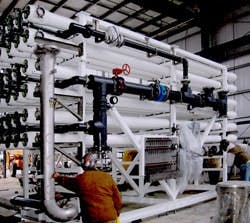Brian Fraser and David Osgood
undefinedThe residents of Brockton, Mass., can finally water their lawns. This is a big deal because Brockton is transitioning from water bans to water surplus, ending a century-long water shortage. The industrialized and densely populated suburbs around the Boston area continue to grow, which has put a strain on the aquifer that supplies groundwater for municipal drinking water. To end the shortage once and for all, the city has embraced desalination.
To resolve quality issues, Inima USA was awarded a design-build-operate contract to provide a regional desalination plant. The Kansas-based Layne Christensen Company provided the reverse osmosis (RO) equipment and related services. After extensive pilot testing of the pretreatment and RO and long discussions about the intake and brine discharge processes, the Massachusetts Department of Environmental Protection and the community accepted a desalination solution.
The system is comprised of three skids, each with an initial flow of 1.1 million gal per day (mgd), using a 24:12 single pass array. The membrane treatment plant was designed with expansion in mind. By adding pressure vessels and membranes, the future build-out potential is for 2 mgd, each using a 36:12 array. Because of their large size, skids were built in two pieces for shipping purposes and then bolted together onsite.
Fourteen miles from the mouth of the Taunton River, on the West bank, the newly constructed Taunton River Desalination Plant has an initial capacity of 5 mgd and can be expanded in the future to 10 mgd. Not only does Brockton have ample water to satisfy its needs into the foreseeable future, it has a sellable surplus for surrounding communities, making future growth and development possible.
